Symbiota Data Fields
The Symbiota data schema is strongly aligned to the Darwin Core data exchange standard. For more details, links to the Darwin Core definitions are supplied for each term. Learn more about Darwin Core terms in the following TDWG pages:
Fields listed here differ from the fields visible in the data uploading tools. For field information specific to the data upload tools, see the Data Import fields page.
Since portals have the ability to customize the field names found on their data entry form, field names may differ from the core field definition and how it is mapped to Darwin Core export tools.
Standard Fields
Collector Info
 |
|---|
| Collector Info section of the Occurrence Editor form |
Catalog Number
The unique identifier (primary key) for the specimen record. This field should be used to store the barcode or the accession number (herbaria only). This field is enforced to be unique per collection.
Examples: WIS-L-0123456, ASUCOB0012345
See Darwin Core's catalogNumber
Additional Identifier Values
Any other identifier for a specimen record that is not the central catalog number. This field is typically used to store the old catalog numbers, accession numbers, National Park identifiers, etc. Identifiers can be assigned a tag name to distinguish it from other identifiers (e.g. old accession #, NPS#, etc). These identifiers map best to dwc:otherCatalogNumbers definition, and thus included in the exports under this field. More information about this system can be found on the Catalog Numbers documentation page.
Examples: TUZI 3082 NPS Acc #: GUIS-M-00126
See Darwin Core's otherCatalogNumbers and the Alternative Identifiers extension.
Collector
The name of the person who collected the specimen or made the observation.
Examples: C.G. Pringle Goodding, L.N. John Wesley Powell
See Darwin Core's recordedBy
Associated Collectors
Other collectors that were present at the time of collection.
Examples: John R. Reeder, Alan Nelson
This field is not defined by the Darwin Core standard, which places primary and secondary collectors concatenated the recordedBy field.
Number
The collection number assigned to the specimen by the collector.
Examples: 1294 12490b 94-132
See Darwin Core's recordNumber
Date (start)
The date the specimen was collected or, if a range of dates is indicated, the first day in the range of collecting dates. While dates can be entered using your preferred format, the value will be converted and stored as an ISO-8601 numeric format (YYYY-MM-DD). Note that unknown month and days can be entered as "00". For example, a collection with a date of "March 1956" can be entered as "1956-03-00".
Examples: 1983-09-15 1983-07-00 1934-00-00
See Darwin Core's eventDate
End Date
The last date of collection, in the case of a range of collecting dates. While dates can be entered using your preferred format, the value will be converted and stored as an ISO-8601 numeric format (YYYY-MM-DD). Note that unknown month and days can be entered as 00. For example, a collection with a date of "March 1956" can be entered as 1956-03-00.
Examples: 1983-09-15 1983-07-00 1934-00-00
See Darwin Core's eventDate
Verbatim Date
The date of collection/observation exactly as provided on a label or in field notes. Particularly useful for non-standard date formats or date ranges.
Examples: Spring 1901 March-April 1952 late Sept. 1909
See Darwin Core's verbatimEventDate
Latest Identification
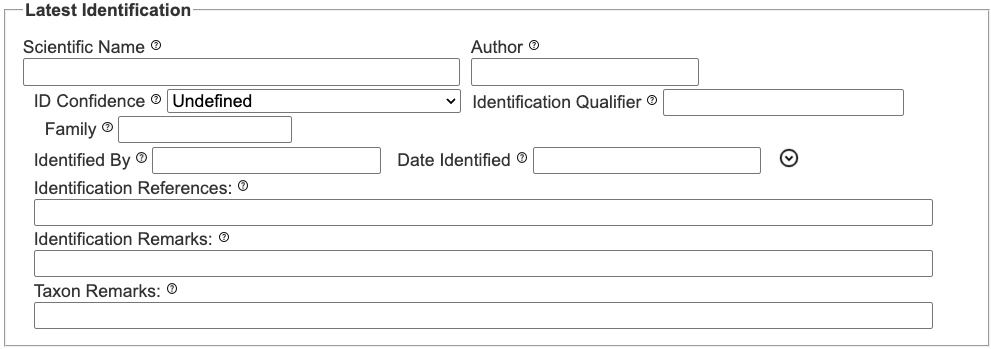 |
|---|
| Latest Identification section of the Occurrence Editor form |
Scientific Name
The Latin name of the specimen without the author. Could be anything from kingdom down to subspecies or variety, depending on the level of the identification.
Examples: Pinaceae Pinus Pinus edulis Pinus edulis var. fallax
See Darwin Core's scientificName
When directly entering data into Scientific Name using the Occurrence Editor, a dropdown menu may appear based on your portal's internal Taxonomic Thesaurus to aid data entry. Taxa not included in the dropdown list can still be entered and saved.
Author
The name of the person who first named the taxa. This field autofills after entering the scientific name. If the name entered in the Scientific Name field is present in the taxonomic thesaurus, this field will be automatically populated from the taxonomic thesaurus. Formatting convention may vary by discipline, e.g. botany vs. zoology.
Examples: L. A. Gray (Anderson, 1938)
See Darwin Core's scientificNameAuthorship
Identification Qualifier
The determiner's expression of uncertainty in their identification. This will be listed on the label along with the scientific name.
Examples: cf. aff. ?
See Darwin Core's identificationQualifier
Family
The family to which the taxon in Scientific Name belongs. If the name entered in the Scientific Name field is present in the taxonomic thesaurus, this field will be automatically populated from the taxonomic thesaurus.
Examples: Pinaceae Mephitidae
See Darwin Core's family
Identified By
The name of the person who identified the specimen. Also called a determiner.
Examples: Leslie R. Landrum
See Darwin Core's identifiedBy
Date Identified
The date the identification was made. Date can be entered as free form text and do not need to be in a standard date format.
Examples: 1992 May 1992 2 May 1992
See Darwin Core's dateIdentified
Identification References
The reference source used to make the identification.
Examples: Nesom, Guy L. 2006. Flora of North America - Asteraceae. vol. 20
See Darwin Core's identificationReferences
Identification Remarks
Any additional notes regarding the identification of the specimen.
Examples: petals pink but calyx length more characteristic of S. angustifolium determination based on size and shape of testes
See Darwin Core's identificationRemarks
Taxon Remarks
Any additional notes regarding the taxonomic name to which the specimen was identified. In biological collections, this field is often where vernacular names are stored.
Examples: Taxon likely no longer valid Smalley's wooly aster
See Darwin Core's taxonRemarks
Locality
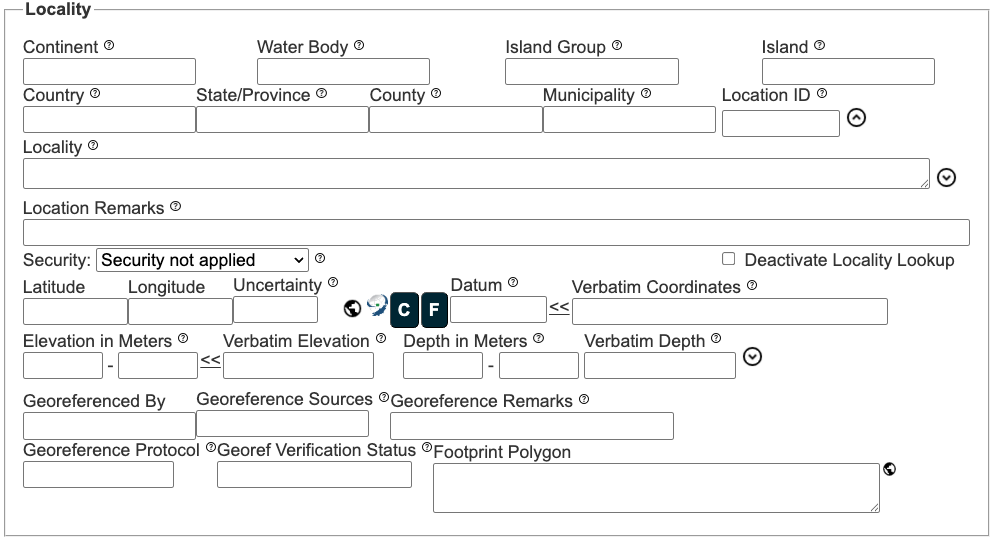 |
|---|
| Locality section of the Occurrence Editor form |
Continent
The name of the continent in which the specimen was collected.
Examples: South America Australia
See Darwin Core's continent
Water Body
The name of the water body in which the specimen was collected.
Examples: Pacific Ocean Black Sea
See Darwin Core's waterBody
Island Group
The name of the island group in which the specimen was collected.
Examples: Hawaiian Islands Alexander Archipelago
See Darwin Core's islandGroup
Island
The name of the island on which the specimen was collected.
Examples: Cayo Coco Maui
See Darwin Core's island
Country
The name of the country in which the specimen was collected. To aid data entry, a dropdown menu will appear as one types, though names outside of the list can still be entered.
Examples: United States Brazil Togo
See Darwin Core's country
State/Province
The name of the state or province in which the specimen was collected. To aid data entry, a dropdown menu will appear as one types, though names outside of the list can still be entered.
Examples: New York Hidalgo
See Darwin Core's stateProvince
County
The name of the county in which the specimen was collected. To aid data entry, a dropdown menu will appear as one types, though names outside of the list can still be entered. For non-U.S. records, enter the next geographic region below state/province.
Examples: Maricopa Washington
See Darwin Core's county
When directly entering data into Country, State/Province, and County using the Occurrence Editor, a dropdown menu may appear based on your portal's internal Geographic Thesaurus to aid data entry. Values not included in the dropdown list can still be entered and saved.
Municipality
The name of the municipality in which the specimen was collected. For specimens collected outside of the United States, enter the 4th level geographic designation.
Examples: Paradise Valley
See Darwin Core's municipality
Locality
The detailed location in which the specimen was collected.
Examples: 9.5 miles NW of Sedona along Boynton Pass Rd.
See Darwin Core's locality
Location ID
An identifier for the set of location information (data associated with dcterms:Location). May be a global unique identifier or an identifier specific to the dataset.
Examples: https://opencontext.org/subjects/768A875F-E205-4D0B-DE55-BAB7598D0FD1 USNM loc. 2126
See Darwin Core's locationID
Location Remarks
Comments or notes about the locality.
Examples: Previously known as Mt. Evans Locality no longer accessible
See Darwin Core's locationRemarks
Security
Selecting Locality Security applied from the dropdown meny will hide locality details below the level of county from unauthorized users. This is typically done because the species is rare or threatened, or because the collection location is private. Images or other media are also hidden to protect locality details that might be viewable from the label. Users that are logged into the system and have the necessary permission to view locality details (e.g. collection managers) will continue to have access to all data. Locality Security will automatically be applied if the species name is on a portal's Protected Species list (accessible via Sitemap). Selecting Fully Security applied will completely hide the record from all public users who do not have editor or administrator permissions for your collection. Unless legal protections apply, this level of security is generally NOT recommended for most records, as it reduces the discoverability of your collections and obscures valuable data from research and public use. Leaving the Security field at Security not applied will allow default settings to be applied as determined by the sensitive species administrators, which is the recommendation for most records. Refer to the Collection Manager Guide for more information on how data redaction works in Symbiota portals.
This field is not defined by the Darwin Core standard.
Latitude and Longitude
The geographic latitude and longitude in decimal degrees. Latitudes from the southern hemisphere and longitudes in the western hemisphere (e.g. USA) should be entered as negative values. Click on the "Tools" button to enter the coordinates in the degree, minute, seconds (DMS) or the UTM formats. Decimal degrees are the preferred coordinate standard as defined by Darwin Core.
Examples: 34.874022 -111.75774
See Darwin Core's decimalLatitude and decimalLongitude
Uncertainty
The accuracy of the georeference coordinates in meters (numeric value only). This is measured as the radius of a circle where the true point would be found if known. If coordinates are collected using a GPS, than the accuracy would be the error found within the GPS unit (usually around 10m). While previously collected specimens that have coordinates on the label recorded by the collector typically do not state the source of the coordinates (GPS, map, etc), it is typically a good assumption that the coordinates are accurate within one to two hundred meters. If the locality details are vague such as just "Grand Canyon, then the coordinates should be the centroid within the uncertainty encompassing the greater area where the specimen may have been collected. If the locality is Boynton Canyon, Sedona, the uncertainty would be about 1500 m. This field autofills when using GeoLocate for georeferencing.
Examples: 42000 100
See Darwin Core's coordinateUncertaintyInMeters
Datum
The geographic system that was used when determining the coordinates. This field autofills when using GeoLocate or the Mapping tool for georeferencing.
Examples: NAD27 NAD83 WGS84
See Darwin Core's geodeticDatum
Verbatim Coordinates
Coordinate values as transcribed from a specimen label, locality leger, or field notes if they were not originally recorded decimal degrees. If your coordinates are in Degrees-Minutes-Seconds (DMS), Universal Transverse Mercator (UTM), or the Township-Range-Section" (TRS) format, click the "F" button to view the formatting tools. Fill in the appropriate box with the coordinates on your label and select the appropriate "Insert Values" button. Valid values in DMS or UTM formats will automatically convert into decimal degree values. If a value has previously been entered into the Verbatim Coordinates field, you can try to click the double arrows (<<) to the left of this field to try to auto-convert them into decimal degrees format. TRS coordinates cannot be automatically converted in the data entry form, but they may be converted into an appropriate georeference using the GEOLocate tool. For more information about this and about using the coordinate tools, see this tutorial video.
Examples: 34° 13.940' N 112° 2.370' W 12 420944E 4064025N TRS: T40N R32E S29
See Darwin Core's verbatimCoordinates
Elevation in Meters
The elevation in meters at which the specimen was collected. Also called altitude. Use only the left field with the right field blank when a single elevation exists. Use the left field to indicate the minimum elevation in meters and the right field to indicate the maximum elevation in meters.
Examples: 1400 2000
See Darwin Core's minimumElevationInMeters and maximumElevationInMeters
Verbatim Elevation
The verbatim elevation at which the specimen was collected. This is typically used to record an elevation measurement that was recorded in feet or an uncertainty designation. When the elevation in meters field is left blank, the value will automatically be converted to meters. Select the double arrows (<<) to replace the previously entered meters values.
Examples: 4500ft 4500 feet ca 4500' ca 2000m 4500' +-300'
See Darwin Core's verbatimElevation
Depth in Meters
The range of depth below the local surface, in meters. Use the left field to indicate the minimum depth in meters and the right field to indicate the maximum depth in meters.
Examples: 100 1042
See Darwin Core's minimumDepthInMeters and maximumDepthInMeters
Verbatim Depth
The original verbatim description of the depth below the local surface at which the specimen was collected.
Examples: 100ft 100 feet ca 100' ca 30m 100' +-10' 7 fathoms
See Darwin Core's verbatimDepth
Georeferenced By
The name (or username) of the person who georeferenced the specimen record. This field autofills when using GeoLocate for georeferencing.
Examples: Amanda Gonzales emakings acbarber
See Darwin Core's georeferencedBy
Georeference Sources
The tool or tools used to georeference and any references consulted to georeference the record.
Examples: GeoLocate Google Earth USGS 1:24000 Florence Montana Quad 1967
See Darwin Core's georeferenceSources
Georeference Remarks
Notes regarding the georeferencing of the specimen.
Examples: placed point at centroid of city, error radius to the extend of city boundaries as viewed on Google Satellite
See Darwin Core's georeferenceRemarks
Georeference Protocol
The source of the standards used to georeference.
Examples: Georeferencing Quick Guide. Zermoglio et al. 2020 Engelbrecht, I. 2021. https://doi.org/10.3897/biss.5.73572
See Darwin Core's georeferenceProtocol
Georef Verification Status
A status used to indicate whether or not the geoference has been reviewed or verified.
Examples: reviewed not reviewed needs verification verified by collector
See Darwin Core's georeferenceVerificationStatus
Misc
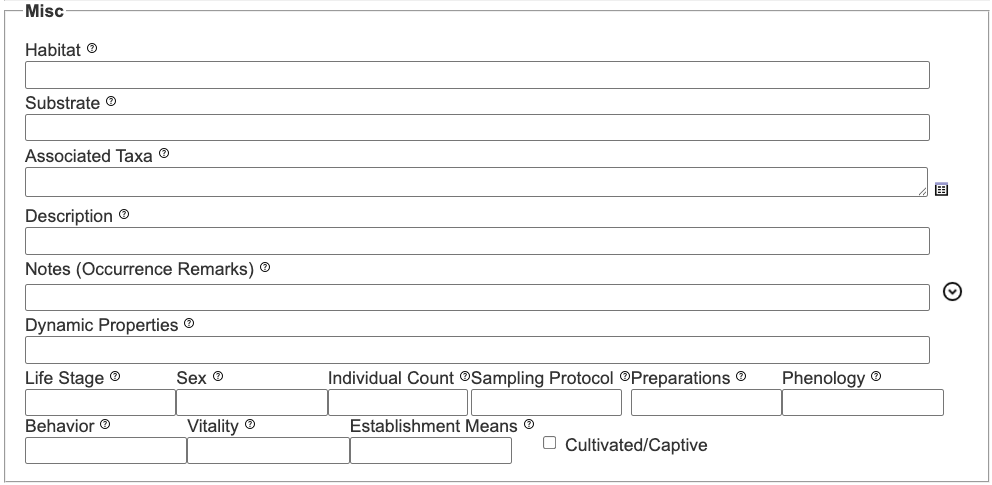 |
|---|
| Misc section of the Occurrence Editor form |
Habitat
The description of the habitat in which the specimen was collected.
Example: Wet areas along a small stream in chaparral deciduousForest; slope aspect: 154; slope gradient: 2.29; soil type order: Inceptisols
See Darwin Core's habitat
Substrate
The substrate on which the specimen was collected (mostly used for lichens, bryophytes, and zoological specimens).
Examples: on basalt trunk of oak
Darwin Core currently lumps this information into dwc:habitat.
Associated Taxa
A list of the names of other species occurring with the collected specimen.
Examples: Quercus, Arctostaphylos, Ceanothus, Rhus, Eriogonum, Salvia
See Darwin Core's associatedTaxa
Description
A physical description of the specimen at the time of collection. This often includes information that can be lost or difficult to observe after the collection and preservation process. For fossil collections: A description that contextualizes what the cataloged fossil material physically represents.
Examples (botany): Shrub 3 m tall corolla yellow
Examples (fossils): Bones are included in the composite mount of USNM V 10304 1 plastercast with 5 remnants of the original specimen
This field is not supported by Darwin Core and is concatenated into occurrenceRemarks when downloaded as a Darwin Core Archive.
Notes
Any additional notes regarding the specimen occurrence at a place in time. Avoid using this field unless a more appropriate data field does not exist.
Examples: common in this region this specimen collected as part of master's thesis project
See Darwin Core's occurrenceRemarks
Dynamic Properties
A list of additional measurements, facts, characteristics, or assertions about the specimen in a format that allows programmatic parsing of the data, e.g. in separator-delimited key:value pairs.
Examples: awnLengthInMeters=0.014, heightInMeters=1.5, relativeHumidity=28, airTemperatureInC=22 totalLength: NA | weight: 25 g
See Darwin Core's dynamicProperties
Life Stage
The age or stage of the organism at the time of collection/observation (typically used for zoological collections).
Examples: larva juvenile adult
See Darwin Core's lifeStage
Sex
The biological sex of the occurrence.
Examples: female male gynandromorph
See Darwin Core's sex
Individual Count
The number of individuals represented by the occurrence. For fossil collections: include a quantity descriptor.
Examples: 2 15
Examples (fossils only): 2 item(s) 200 estimate
See Darwin Core's individualCount
Sampling Protocol
The names and references to methods used to collect or sample an occurrence.
Examples: UV light trap mist net Takats et al. 2001. Guidelines for Nocturnal Owl Monitoring in North America. Beaverhill Bird Observatory and Bird Studies Canada, Edmonton, Alberta. 32 pp., http://www.bsc-eoc.org/download/Owl.pdf
See Darwin Core's samplingProtocol
Preparations
Preparation or preservation method for a specimen. While no universal controlled vocabulary currently exists for this field, a practical example for biological collections can be found here.
Examples: in ethanol study skin pressed and dried part-counterpart
See Darwin Core's preparations
Phenology (Reproduction Condition)
The reproductive stage the specimen is in.
Examples: flower fruit sterile
See Darwin Core's reproductiveCondition
Behavior
The behavior exhibited by the organism/occurrence at the time of collection/observation.
Examples: flying sitting on eggs
See Darwin Core's behavior
Vitality
An indication of whether the organism was alive or dead at the time of collection or observation.
Examples: live dead
See Darwin Core's vitality
Establishment Means
The state or quality of establishment of the individual at the time of collection.
Examples: cultivated invasive native
See Darwin Core's establishmentMeans
Cultivated Checkbox
Check this box when the organism was established with the aid of humans at the time of collection. This true/false field enables the ability to filter non-native or naturalized species.
This field is not currently supported by Darwin Core and is therefore not included in Darwin Core exports.
Curation
 |
|---|
| Curation section of the Occurrence Editor form |
Type Status
The type designation of a specimen, whether it is a name-bearing specimen or part of a type series.
Examples: holotype isotype paratype
See Darwin Core's typeStatus
Disposition
The location or status of the physical specimen with respect to a collection.
Examples: missing on loan in collection stored under genus "Mimulus"
See Darwin Core's disposition
Occurrence ID (override)
The Globally Unique Identifier (GUID) for the specimen. This value should be stable and uniquely identify the specimen relative to all other specimens within the world. If your collection is set to have occurrenceIDs/GUIDs generated by the portal (this is the suggested setting for all live-managed collections), this field will appear blank in the Occurrence Editor form. To view the occurrenceID value associated with your specimen, click the Public Display link at the top of the page.
Examples: 000866d2-c177-4648-a200-ead4007051b9 urn:catalog:UWBM:Bird:89776
See Darwin Core's occurrenceid
Field Number
An identifier given to the collecting event in the field. This number often serves as a link between the event indicated in the field notes and the specimen record.
Examples: 2024-04-05-00045 JOSHUATREE_35 2025AH0718-01
See Darwin Core's fieldnumber
Language
The language of the label information or record.
Examples: en es pt fr
See Darwin Core's language
Label Project
A value used to group records from a specific project or category for internal use. Once a value is entered in this field, all records with that same value can be printed at one time using the batch label printing tools
Examples: Plants of Sedona 2012 PCC TCN 2018
This field does not map the Darwin Core and is excluded from Darwin Core Archive exports.
Dupe Count
The number of duplicate botanical specimens created. This will dictate the number of labels printed for specimen.
Examples: 10 2
See Darwin Core's duplicatequantity
Institution Code (override)
The acronym of the institution that stewards this occurrence. Only enter a value if it differs from what is entered in the collection's metadata in the portal.
Examples: NMNH FLMNH
See Darwin Core's institutionCode
Collection Code (override)
The acronym of the collection that stewards this occurrence. Only enter a value if it differs from what is entered in the collection's metadata in the portal.
Examples: Herps F
See Darwin Core's collectionCode
Owner Code (override)
The name (or acronym) in use by the institution having ownership of the object(s) or information referred to in the record. Only enter a value if it differs from what is entered in the collection's metadata in the portal.
Examples: NPS BLM NMNH
See Darwin Core's ownerInstitutionCode
Basis of Record
The type of record the specimen is classified as. For collections of physically preserved specimens, this field defaults to PreservedSpecimen or FossilSpecimen depending on how your collection is configured; for observation projects, the default is HumanObservation.
Examples: PreservedSpecimen LivingSpecimen HumanObservation MaterialCitation FossilSpecimen
See Darwin Core's basisOfRecord
Processing Status
The status of the digital record. This field is intended to facilitate collection-specific internal data management and review. The values used are dictated by the specific workflow of each institution.
Examples: Reviewed Pending Review Stage 1
This field does not map the Darwin Core and is excluded from Darwin Core Archive exports.
Data Generalizations
Internal notes associated with the occurrence record. Data entered in this field is not visible on the public search form, but it can be viewed in a Darwin Core Archive download.
Examples: data reviewed on 2025-05-12 potential issues with georeferencing, to be reviewed by curator
See Darwin Core's dataGeneralizations
Special Module-specific Fields
The following data fields correspond to modules that may not be available in all Symbiota portals. Some modules may require community discussion to activate. Contact your Portal Manager for more information.
Material Sample
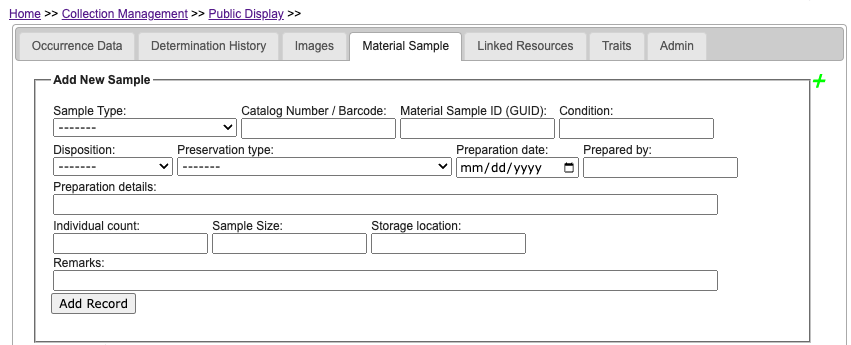 |
|---|
| Material Sample tab on the Occurrence Editor form |
Controlled vocabularies for Material Sample data fields are managed per portal, and the suggested examples provided below are derived from vocabularies used for the NEON Biorepository. These vocabularies vary by portal, and modifications may require community input. Contact your Portal Administrator for more information.
Sample Type
The sample type, which is often anatomical in nature. Controlled vocabulary enforced on a per-portal basis.
Examples: skull liver gastrointestinal tract genetalia DNA
See the GGBN Material Sample Extension's materialSampleType
Catalog Number / Barcode
A unique identifier for the material sample, analagous to catalogNumber for specimen occurrences.
Examples: D00000044967
See Darwin Core's catalogNumber
Material Sample ID (GUID)
A globally unique identifier for the material sample. In the absence of a persistent global unique identifier, construct one from a combination of identifiers in the record that will make this identifier globally unique.
Example: 06809dc5-f143-459a-be1a-6f03e63fc083
Sample Condition
The physical condition of the sample. Use of a controlled vocabulary is recommended but not required.
Examples: very poor poor fair good unknown
See the GGBN Material Sample Extension's quality
Disposition
The current state of a sample with respect to its collection. Controlled vocabulary enforced.
Examples: in collection being processed consumed on loan deaccessioned missing
Preservation Type
The physical storage/preservation method of a sample. Controlled vocabulary enforced.
Examples: dry ethanol liquid nitrogen pinned/pointed
Preparation Date
The date of a sample's physical preparation. Dates in this field visually conform to MM/DD/YYYY formatting. Manual data entry into this field is validated using a calendar form.
Examples: 08/01/2022 05/14/2025
Prepared By
Name of the individual who prepared a sample, selected from the dropdown list. The individual must have an user account in the portal to be recorded in this field.
Examples: Liao, Rosie Johnston, Andrew
Preparation Details
Notes providing more context about the physical preparation and condition of the sample.
Examples: upper and lower GI tract kidney, left, whole prepared with borax
Individual Count
The number of loanable objects associated with the sample, i.e. all pieces of the sample assigned to the same unique materialSampleID (see above).
Examples: 0 1 100
Sample Size
Quantification of the sample beyond counted number of objects, e.g. dry weight.
Examples: 200 uL 20 g
See GGBN Material Sample Extension's samp_size.
Storage Location
A sample's physical storage location with respect to its collection.
Examples: Freezer 3 Oversize Storage Cab011 | Dwr002
Remarks
Additional notes, comments, and context unique to a sample that cannot be captured by other existing data fields.
Examples: genotype sampling left jaw consumed in research with post-cranial skeleton
Paleontology
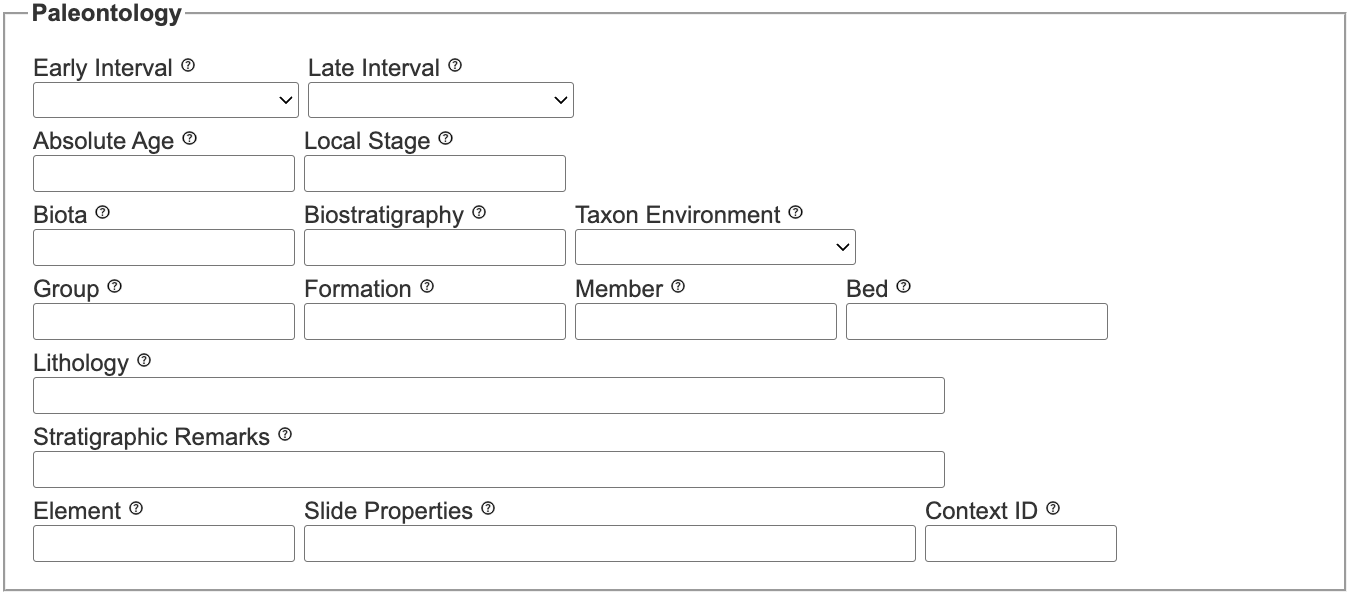 |
|---|
| Paleontology/Geological Context fields on the Occurrence Editor form |
Early Interval and Late Interval
The earliest (geologically oldest, i.e. "Early Interval") and latest (geologically youngest, i.e. "Late Interval") possible intervals of geological time attributable to the stratigraphic horizon from which the cataloged fossil material was collected. Every Early Interval value entered should have a corresponding Late Interval value; likewise, these values should be logical, i.e. the Early Interval value should be either the same as or geologically older than the Late Interval value. Use values from the ICS time scale to maximize data interoperability unless directed differently by your Portal Manager. Correctly entered values will automatically populate the hierarchical series of corresponding Darwin Core terms (see examples below).
Example 1: Early Interval = Eocene and Late Interval = Oligocene
Example 2: Early Interval = Eocene and Late Interval = Eocene
Incorrect (missing value): Early Interval = Eocene and Late Interval = null/blank
Incorrect (illogical order): Early Interval = Oligocene and Late Interval = Eocene
For Early Interval, see also Darwin Core’s earliestEonOrLowestEonothem, earliestEraOrLowestErathem, earliestPeriodOrLowestSystem, earliestEpochOrLowestSeries, and earliestAgeOrLowestStage.
For Late Interval, see also Darwin Core’s latestEonOrHighestEonothem, latestEraOrHighestErathem, latestPeriodOrHighestSystem, latestEpochOrHighestSeries, and latestAgeOrHighestStage.
Late Interval
See above for Early Interval and Late Interval.
Absolute Age
The numerically resolved age of the cataloged fossil material in years determined using absolute dating techniques, such as radiocarbon/carbon-14 dating, K-Ar, U-Pb, and Ar-Ar dating, etc.
Examples: 20 Ma 75 ka 10.5 – 12.7 +/- 0.5 Ma
Storage Age
Physical storage location of the cataloged fossil material within the collection space.
Examples: Cabinet: 1 | Tray 4 Miocene Cabinet Bridgerian
Local Stage
The name of an interval in geological time that is used locally or regionally but isn’t necessarily internationally accepted, such as a North American Land Mammal Age.
Examples: Barstovian Povolzhian Ulatsian Helvetian
Biota
The name given to various collections of fossils of the same geological time interval as the cataloged fossil material, typically from one or more localities within a specific geographic area.
Examples: Chalk Bluffs Stewart Valley Bridge Creek Mazon Creek
Biostratigraphy
The name of the biostratigraphic unit from which the cataloged fossil material was collected.
Examples: Wa0 Uvigerinella sparsicostata Zone Ogygiocaris
See Darwin Core's lowestBiostratigraphicZone and highestBiostratigraphicZone
Taxon Environment
The depositional environment of the rock unit from which the cataloged fossil material was collected. A controlled vocabulary is enforced.
Examples: marine non-marine marine and non-marine
Group
The name of the lithostratigraphic group from which the cataloged fossil material was collected. Data providers may wish to refer to the National Geologic Map Database Geolex Search to standardize values according to lithostratigraphic names accepted by the US Geological Survey.
Examples: Bathurst Lower Wealden Monte Cristo Contra Costa Panoche
See Darwin Core's group
Formation
The name of the lithostratigraphic formation from which the cataloged fossil material was collected. Data providers may wish to refer to the National Geologic Map Database Geolex Search to standardize values according to lithostratigraphic names accepted by the US Geological Survey.
Examples: Notch Peak House Limestone Fillmore Chinle
See Darwin Core's formation
Member
The name of the lithostratigraphic member from which the cataloged fossil material was collected. Data providers may wish to refer to the National Geologic Map Database Geolex Search to standardize values according to lithostratigraphic names accepted by the US Geological Survey.
Examples: Lava Dam Hellnmaria Brown Mountain Sandstone
See Darwin Core's member
Bed
The name of the lithostratigraphic bed from which the cataloged fossil material was collected. Data providers may wish to refer to the National Geologic Map Database Geolex Search to standardize values according to lithostratigraphic names accepted by the US Geological Survey.
Example: Harlem coal
See Darwin Core's bed
Lithology
The rock/sediment types from which the cataloged fossil material was collected.
Examples: sandstone mudstone siltstone shale
Stratigraphic Remarks
Additional details about the cataloged fossil material’s geological and/or stratigraphic context that cannot be captured using other fields, such as more detailed information about where a specimen was collected in relation to a measured stratigraphic section or context for palynological sampling, core data, etc.
Examples: Fossil collected ~1.5m from the base of the stratigraphic section originally described by Alderson, 1981. Specimen collected 150 feet below top of unit.
Element
The anatomical element(s) represented by the cataloged fossil material. Recommendation is to use a discipline-specific controlled vocabulary and to pipe-separate distinct values. Record more verbose anatomical descriptions in Description.
Examples (invertebrates): pygidium/pygidia thorax
Examples (vertebrates): skull: dentary skull: maxilla vertebra: centrum
Examples (paleobotany): stem strobilus root pinnule(s)
Examples (ichnofossils): vertebrate trackway
Slide Properties
Information about prepared slides derived from the cataloged fossil material, noting details like the type of preparation and mounting medium. England Finder coordinates may be recorded in this field, e.g. for palynomorph slides.
Examples: strewn petrographic thin-section mounted peel
Geological Context ID
An identifier for the set of information associated with the cataloged fossil material’s GeologicalContext, e.g. Group, Formation, Member, Bed, Early/Late Interval. Ideally, this should be a global unique identifier or an identifier specific to the data set.
Example: https://opencontext.org/subjects/e54377f7-4452-4315-b676-40679b10c4d9 https://macrostrat.org/sift/#/strat_name_concept/8320
See Darwin Core's geologicalContextID